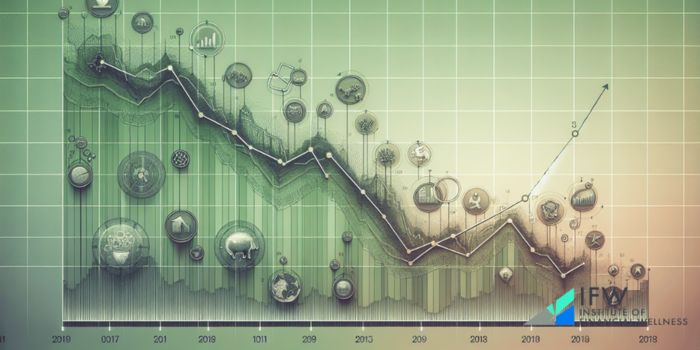“Retirement is not the end of the road; it’s the beginning of the open highway.” – Unknown
Ever wondered why traditional pensions took a backseat to modern retirement plans? Dive into the driving forces behind this major shift affecting countless retirees. Economic pressures, changing workforce needs, and the ascent of plans like 401(k)s are at the core. This transformation has reshaped the retirement scene, introducing financial responsibilities and uncertainties. Let’s go for an in-depth look at these pivotal factors and their impact on your retirement strategy.
Key Takeaways
- Pension plans are declining due to economic strains on companies, shifts in workforce preferences, and the complexity of managing them. Only a small fraction of new employees at smaller companies have access to defined benefit plans, exemplified by corporations like General Electric and IBM freezing their pension plans.
- Defined contribution plans like 401(k)s are on the rise, offering tax benefits, ease of savings through automatic deductions, and reduced employer liabilities. However, they shift the retirement planning and investment risks to employees, who must be proactive in managing their retirement funds.
- Without traditional pensions, individuals need to focus on maximizing Social Security, investing in IRAs and other retirement accounts, and diversifying investments to secure their retirement. Industries like utilities and teaching still offer pensions, but overall, individuals bear the primary responsibility for financial planning for their retirement.
The Decline of Pension Plans
The prevalence of traditional defined benefit pension plans, which offered employees retirement benefits, has significantly decreased over the years. Currently, only 14% of private sector workers have access to such plans compared to 60% in the past [1].
This trend is observed across all types of companies, both large and small. Many major corporations, including General Electric, IBM, Verizon, and others.
Lockheed Martin and Motorola have frozen their pension plans and stopped accruing benefits for vast majority of their employees. Even smaller businesses with less than 50 workers offer limited access to defined benefit pensions, as only 57% of new hires are eligible [2].
It is no longer common for most employees to anticipate a secure future through a company’s defined benefit plan offering stable pension benefits. The number of these traditional schemes continues on an unfortunate decline that affects all levels within organizations, from top executives down.
Economic Factors
Traditional pension plans have been on the decline, primarily due to the economic strain they place on companies. Employers often bear the heavy responsibility of fully funding these plans; a task made more challenging by unpredictable market volatility and fluctuating investment returns.
Besides the financial implications, the complexity of managing pension plans also proves to be a daunting task for companies. Estimating pension liabilities and adhering to government regulations are challenging, prompting many companies to explore alternative options.
Furthermore, the need for government bailouts of underfunded pension plans has raised concerns about the sustainability of pension plan guarantees, adding another layer of uncertainty to the mix.
Shift in Workforce
As the workforce changes, so do their preferences and needs. One noticeable shift is that younger workers now favor savings-based retirement plans, creating new complexities in managing employees.
The trend towards more defined contribution plan options such as 401(k)s has gained popularity among employees but also presents unexpected challenges when it comes to retaining workers. Union membership traditionally advocates for maintaining pension plans. Its prevalence is declining, which accelerates the move away from conventional defined-benefit pensions.
The Rise of Defined Contribution Plans

As traditional pension plans become less prevalent, 401(k) accounts have emerged as a popular alternative. These defined contribution plans have been in existence since the 1980s and are now a commonly chosen option for retirement among American workers. In 2020, there are approximately 600,000 active 401(k) plans, with around 60 million employees participating in them – making up almost one-fifth of the entire U.S. retirement market [3].
The increasing popularity of defined contribution plans can be attributed to the many advantages they offer employees. Most notably, these types of pensions provide tax benefits by allowing pre-tax contributions, which effectively reduce an employee’s taxable income. Besides that, they also facilitate automated savings through automatic paycheck deductions making it easier for individuals to consistently save enough money towards their retirement funds without having to make manual contributions each time.
Traditional pensions are fading. Now it’s your turn to build one.
Request your Retirement Score and start creating your own pension plan today.

Advantages for Employers
Defined contribution plans offer multiple advantages for employers, and local government workers including lower costs and simpler management compared to traditional pension plans. These types of retirement benefits are also a sustainable option for employees.
Through defined contribution plans, employers have the ability to decrease their financial obligations by not guaranteeing a specific retirement income. They can outsource administrative responsibilities related to these plans in order to alleviate some of the burden on themselves. Offering matching contributions at typically half the rate (up until a certain percentage) helps attract and retain valuable employees through 401(k)s.
Impact on Employees
While there are benefits to defined contribution plans, the transition away from traditional employer-funded pension plans has created new difficulties for workers. With many employers now no longer responsible for retirement saving and investing, employees now carry a greater burden and face increased risks as they rely more heavily on market performance.
In today’s world dominated by defined contribution plans, individuals must take a proactive approach to managing their own retirement savings. The success of their retirements is largely determined by individual investment decisions and the ability to weather market fluctuations. This shift has also opened the door for potential early withdrawals or loans against pension accounts, making planning for retirement even more complex.
Strategies for Retirement Without a Pension

In the absence of a more traditional pension plan, individuals must take the reins of their retirement planning. Asset allocation and limiting spending are crucial strategies to ensure a secure retirement. This aligns with effective financial planning and retirement readiness, which are more essential than ever in the landscape of self-funded retirement.
However, many workers are not accumulating adequate retirement savings in their defined contribution plans. The frequent cashing out of these plans upon changing jobs jeopardizes their financial security in retirement. Therefore, individuals carry the primary responsibility for their financial security in retirement, necessitating proactive management of savings and investments.
Maximizing Social Security Benefits
Maximizing Social Security benefits is a key strategy for individuals planning their retirement without a pension. A smart approach would be to delay collecting these benefits until reaching full retirement age or even waiting until the age of 70, as this can lead to an increase in the monthly payment due to an annual growth rate of 8%. Having at least 35 years of work experience contributes significantly towards calculating a higher social security benefit since it takes into account the average earnings from one’s top-earning decades [4]. It is also important for retirees to have knowledge about spousal and survivor benefits which can greatly supplement their income during retirement.
Aside from personal factors such as delaying collection and accumulating enough work experience, understanding dependent support options provided by Social Security can greatly enhance overall retirement income. In cases where dependents are under the age of nineteen, they may receive up to two annuity payments and fifty percent of additional payments based on what was received by retired workers, providing extra financial assistance for retirees with families.
When making plans regarding your post-retirement finances, especially if you do not have access to other sources like pensions. Carefully considering different aspects related to maximizing social security payouts should be taken seriously so that suitable adjustments can be made accordingly, leading to improved sustainability in terms of income both before & after leaving the workforce.
Investing in IRAs and other Retirement Accounts
Retirement saving strategies should include investing in Individual Retirement Accounts (IRAs) due to their tax benefits. Beginning in 2027, the savings credit will directly match contributions made by low and middle-income taxpayers into their retirement accounts, increasing the advantages of utilizing these savings vehicles.
To IRAs, defined contribution plans such as 401(k)s have higher allowable contribution limits, which can allow employees to save more for retirement. Thus, making full use of these plans is essential for building a solid foundation for future income during retirement.
You may not have a pension—but you can build your own.
Diversifying Investments
Retirement portfolio management emphasizes the importance of diversification. This involves investing in a variety of assets, such as stocks, bonds, cash, real estate, and commodities, with the goal of minimizing risk and optimize returns. Each asset class responds differently to market conditions. For instance, while stocks offer long-term growth potential, bonds provide more stable earnings through fixed payouts.
To create a well-diversified IRA portfolio, tools like mutual funds and exchange-traded funds (ETFs) can be utilized. These allow investors to gain exposure to multiple assets with just one investment vehicle. Index funds and ETFs are particularly effective options that cover a wide range of investments under one roof. Real estate is another avenue for diversification as it offers both income-generating opportunities along with the possibility of appreciation over time. Similarly, annuities serve dual purposes by providing consistent streams of income while also safeguarding against unpredictable fluctuations in the market.
In retirement planning, diversifying your investments is crucial. Assets should include various vehicles like mutual funds, along with being invested in commonly used instruments. Some examples could include stocks, bonds, and other types of property. Financial stability comes down to making sound decisions concerning financial security that depend significantly on volatile market swings. The aim of choosing different avenues is to reduce risks while increasing investment performance. An additional medium aimed at decreasing thishazard include real-estate options that provide opportunity for yearning regular gains without being fully dependent on the stocks market.
Industries Still Offering Pensions

Despite a general decline, there are still some industries that offer traditional pension plans in the private sector. These include teaching, state and local government roles, utilities, and protective services.
Labor statistics show that within the utility industry, 76% of employees have access to pension coverage, while public school teachers enjoy one of the highest enrollment rates at 90% [5]. In contrast, workers in the private industry may have varying levels of coverage for defined benefit pensions.
State and local government jobs, particularly those held by union members or individuals employed by local governments, often provide opportunities for employees to enroll in defined-benefit pension plans. Transportation workers also stand a good chance with a 40% eligibility rate, whereas personnel working in protective services, like police officers or firefighters, can expect around 58% [6].
Navigating Buyouts and Lump Sum Payments
For those who are fortunate enough to still have a pension, making decisions about buyouts and lump sum payments is an important aspect of planning for retirement. A pension buyout offer, also known as an early retirement offer, refers to a cash payment from the employer to the employee that typically represents only part of the future value of their pensions. Accepting this one-time payment comes with the responsibility of managing it properly, which can be risky without proper financial advice or planning.
Evaluating such offers involves determining how much current value these future pension payments hold to what is being offered as a lump sum. This calculation heavily depends on interest rates because higher rates often lead employers to make lower offers due to reducing their potential liabilities related to the pensions they owe employees. On the one hand, pensioners may appreciate receiving monthly income for life through steady lifetime payments. However, because they do not account for inflation adjustments, future earnings could potentially fall short when compared against stock market gains.
Preparing for a Secure Retirement
Creating a secure retirement requires continuous effort and careful planning. It is crucial to set realistic goals for saving towards retirement, taking into account factors such as desired lifestyle, projected expenses, and current savings. A comfortable retirement life depends not only on the amount saved but also on wise expense management and minimizing debt before leaving work.
In today’s ever-changing financial landscape, staying informed is essential. Changes in legislation or economic conditions can significantly impact retirement benefits. It is important to stay updated with these developments and adjust strategies accordingly during the planning process.
Setting Realistic Goals
To establish realistic retirement savings goals, it is important to have a clear understanding of one’s income level. For instance, the median annual salaries for elementary and high school teachers are $61,690 and $62,360 respectively. Registered nurses earn even higher, with a median salary of $81,220. These figures highlight the importance of setting retirement savings targets based on individual income.
As such, saving for retirement should take into consideration personal earning circumstances, including profession and location. This tailored approach can assist in creating attainable goals that allow individuals to effectively plan for their future post-retirement life.
A retirement score calculator can help you determine how much you need to save for a comfortable retirement based on your current income and other investments.
Managing Expenses and Debt
Managing one’s personal finances effectively, especially in regard to expenses and debt, plays a crucial role in preparing for a secure retirement. This can involve various strategies, such as paying off the mortgage early or downsizing to a smaller home. Some may even consider relocating to an area with lower living costs or selling unnecessary assets like cars that contribute towards loan payments, fuel expenses, maintenance fees, and insurance charges.
To major expenditures mentioned above, cutting down on everyday costs related to groceries, utilities, and insurance can have a significant impact on overall spending during retirement. Evaluating priorities and eliminating non-essential expenses such as unused memberships or subscriptions from one’s budget could also aid in achieving financial stability during the retirement phase of life.
Staying Informed
Staying up to date on changes in legislation and economic conditions is essential for successful retirement planning. The recent implementation of the SECURE 2.0 Act, effective as of December 2022, has brought about a number of modifications to retirement savings accounts, including expanded opportunities for saving and adjusted rules regarding catch-up contributions. It also entails gradually increasing the age at which individuals are required to take minimum distributions from their retirement funds, rising from 72 years old initially to eventually reaching age 75 by the year 2033.
Along with keeping track of legislative shifts, it’s crucial for retirees to monitor their earnings after they begin receiving Social Security benefits since exceeding certain limits can lead to a reduction in those benefits for that particular year. Ensuring the accuracy of one’s Social Security statement is important because this benefit is determined based on an individual’s average income over their top thirty-five earning years.
Collaborating with a financial advisor can be highly beneficial when it comes to managing finances during retirement through means such as budgeting strategies and investment management techniques while navigating unpredictable market fluctuations helps maintain stability throughout these later stages in life.
Navigating Financial Futures: The Institute of Financial Wellness
The Institute of Financial Wellness is a guiding light for those in search of knowledge and preparation for their financial future. Dedicated to promoting financial stability, the institute offers:
- A multitude of helpful tools and advice
- Encouragement for individuals to assume responsibility for their fiscal well-being
- Assistance with navigating through the intricacies involved in planning retirement.
Full Summary
Planning for retirement can be overwhelming due to the changing landscape of pension plans. With traditional pensions being replaced by defined contribution plans, there are now more challenges and opportunities for individuals to take control of their own retirements. It is important to understand these changes, set realistic goals based on your unique circumstances, manage expenses and debt wisely, and stay informed about any shifts in legislation or economic conditions.
There is no one formula that fits all when it comes to planning for retirement – whether you work as a teacher, nurse, or government employee in the private sector. Your journey towards a comfortable retirement will vary, but with careful preparation, active management of savings, and understanding your options thoroughly, you can confidently navigate this path.
Mondays 7:00 pm ET
Webinar: New Rules of Retirement Income Planning
Retirement has changed. Are you prepared? Learn how to build lasting and reliable income.
Reserve My Spot
Frequently Asked Questions
Why don’t they do pensions anymore?
Employers have moved away from traditional pensions due to changes in company structures, increased complexity in managing funds, and the desire to reduce costs and transfer investment risk onto the employee. This shift has been driven by the unpredictability and expense of committing to pay employees for the rest of their lives.
When did the US get rid of pensions?
In the 1980s, the United States started to phase out pensions as a result of new regulations from the Internal Revenue Service. This was sparked by a provision in the 1978 Revenue Act. Act that permitted employees to use pre-tax funds for voluntary contributions towards retirement plans. The decision to make this change was based on encouraging individuals to take more control over their own retirement savings.
Why did 401k replace pensions?
Employers made the switch from traditional pensions to 401(k) plans in order to transfer responsibility for retirement savings onto their employees and decrease long-term financial obligations, ultimately leading to increased overall profits. This decision was also motivated by the desire to shift market risk from employers onto individual workers.
This transition has resulted in a significant change in employee benefits, as it emphasizes the importance of individuals taking control of their own retirement savings through contributions and investment decisions within these defined benefits.
Could pensions come back?
There is a possibility that pensions may experience a resurgence, particularly if defined benefit pension plans are well-funded and effectively managed. These types of pension plans can provide financial efficiency and add value to the company’s balance sheet.
Recent indications from employers, as well as new retirement benefits being offered, also suggest the potential for an upswing in pensions. This could mean better prospects for defined benefit retirements overall.
What strategies can I use to plan for retirement without a pension?
To prepare for retirement without a pension, prioritize increasing social security benefits, further investing money in retirement accounts, diversifying investments, setting achievable savings targets, and effectively managing expenses and debts. Stay updated on economic trends and policies to develop a solid plan for your future financial stability.
By focusing on these strategies, you can create a sound approach towards securing your retirement even without the support of an income stream a traditional pension. Maximizing social security benefits and utilizing various investment options will help build up funds for when you retire while spreading out investments minimizes risks. It is important to keep it in mind.




